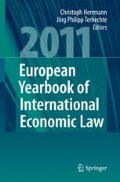Overview
The aim of this report is to trace back and analyse the legal nature of the Association of Southeast Asian Nations (ASEAN) since its birth. Presently, ASEAN is changing its nature from an “association” to an “international organization”. Although ASEAN uses the model of the EU and the WTO for the new ASEAN vision 2020, their legal natures are quite different. ASEAN economic integration is still in the process of changing. The ASEAN Economic Community (AEC) was formed by ASEAN members to create a single market for the region by 2015. This new model of ASEAN will pave the way for regional economic cooperation and integration. Furthermore, it will support the expansion of trade and investment liberalization in this decade. However, it does not mean that ASEAN economic integration will undermine the WTO; to the contrary, it will facilitate the main purposes of the WTO and play a significance role in economic cooperation as a key regional organization and support the basic principles of the WTO.
Access this chapter
Tax calculation will be finalised at checkout
Purchases are for personal use only
Notes
- 1.
The main reason for the establishment of ASEAN was a political one because Southeast Asia was a region of turmoil and instability in the 1960s and 1970s. After the decolonization period, especially in the early 1960s, Singapore, Malaysia, Brunei and Philippines became independent states, but the colonial heritage provoked a new conflict in this region such as the Sabah dispute, the Vietnam War and the perils of the communist hegemony in Southeast Asia, all of which contributed to the necessity of the establishment of ASEAN.
- 2.
Even in the case of the Treaty of Amity and Cooperation in Southeast Asia of 1976, the treaty does not provide any concrete legal measure to enforce the obligation of ASEAN economic integration. On the contrary, the provisions of this treaty allow the state parties to promote perpetual peace and cooperate in the economic, social, technical, scientific and administrative fields by their own way to fulfil the obligations of cooperation under this treaty in good faith. See Articles 1 and 3 of the treaty. Last but not least, Article 2 confirms the principle of non-intervention. This flexible legal regime of the ASEAN model of cooperation in turn marks a historic starting point of ASEAN economic integration.
- 3.
http://www.asean.org/21861.htm, last accessed: 01.01.2010.
- 4.
http://www.asean.org/24146.htm, last accessed: 01.01.2010.
- 5.
From 1 January 2010, Brunei, Malaysia, Myanmar, Philippines, Singapore and Vietnam have been parties to the AANZFTA. The remaining ASEAN members (Cambodia, Indonesia, Laos and Thailand) are working to ratify AANZFTA at the earliest possible opportunity in 2010.
- 6.
A guide for ASEAN Business -ASEAN-AUSTRALIA-NEW ZEALAND Free Trade Area, ASEAN Secretariat, October 2009, p.5.
- 7.
http://www.asean.org/22244.htm, last accessed: 08.01.2010.
- 8.
http://www.asean.org/24161.htm, last accessed: 08.01.2010.
- 9.
Report of the ASEAN-JAPAN Eminent Persons Group: ASEAN Secretariat, October 2009, p. 3.
- 10.
http://www.asean.org/16580.htm, last accessed: 08.01.2010.
- 11.
Report of the ASEAN-Republic of Korea Eminent Persons Group: ASEAN Secretariat, September 2009, p. 14 items 11 and 12.
- 12.
http://www.matrade.gov.my/cms/content.jsp?id=com.tms.cms.article.Article_hide_ASEANKorea, last accessed: 08.01.2010.
- 13.
http://www.asean.org/23216.htm, last accessed: 08.01.2010.
- 14.
http://www.aseansec.org/22467.htm, last accessed: 09.01.2010. “The ASEAN Secretariat was set up in February 1976 by the Foreign Ministers of ASEAN. However, it was only in 1981 was the existing ASEAN Secretariat established. It was officiated in 1981 by the then-President of Indonesia, H.E. Soeharto”.
- 15.
Article 3 ASEAN Charter.
- 16.
Article 4 ASEAN Charter.
- 17.
Article 5 ASEAN Charter.
- 18.
Section 18 AEC Blueprint reads: “ASEAN Single Window is an environment where ten National Single Windows of individual Member Countries operate and integrate. National Single Window enables a single submission of data and information, a single and synchronous processing of data and information and a single decision-making for customs clearance of cargo, which expedites the customs clearance, reduce transaction time and costs, and thus enhance trade efficiency and competitiveness”.
- 19.
Section 5 AEC Blueprint.
Author information
Authors and Affiliations
Corresponding author
Editor information
Editors and Affiliations
Rights and permissions
Copyright information
© 2011 Springer Berlin Heidelberg
About this chapter
Cite this chapter
Aekaputra, P. (2011). Report on the ASEAN Economic Cooperation and Integration. In: Herrmann, C., Terhechte, J. (eds) European Yearbook of International Economic Law 2011. European Yearbook of International Economic Law(), vol 2. Springer, Berlin, Heidelberg. https://doi.org/10.1007/978-3-642-14432-5_17
Download citation
DOI: https://doi.org/10.1007/978-3-642-14432-5_17
Published:
Publisher Name: Springer, Berlin, Heidelberg
Print ISBN: 978-3-642-14431-8
Online ISBN: 978-3-642-14432-5
eBook Packages: Humanities, Social Sciences and LawLaw and Criminology (R0)

